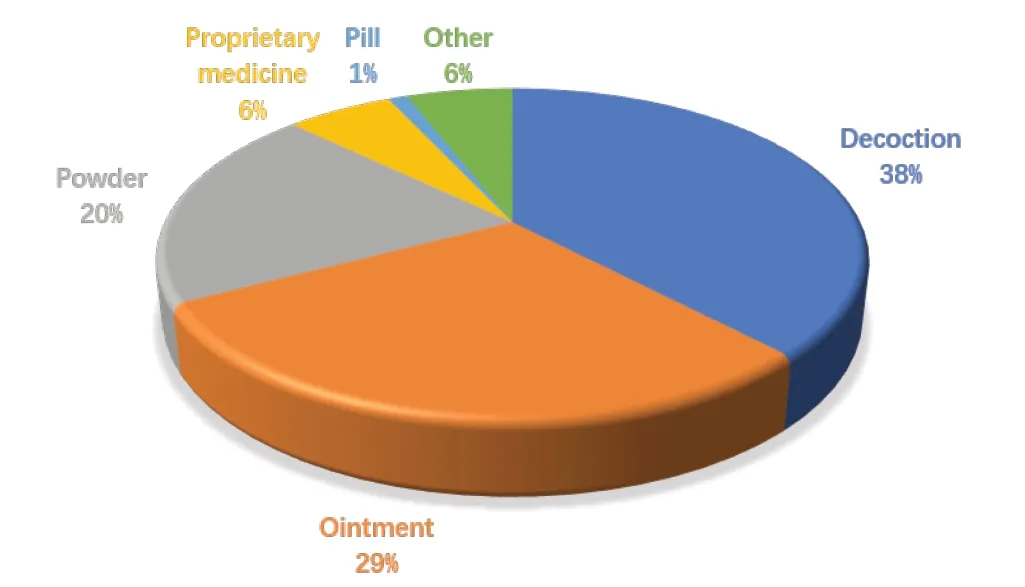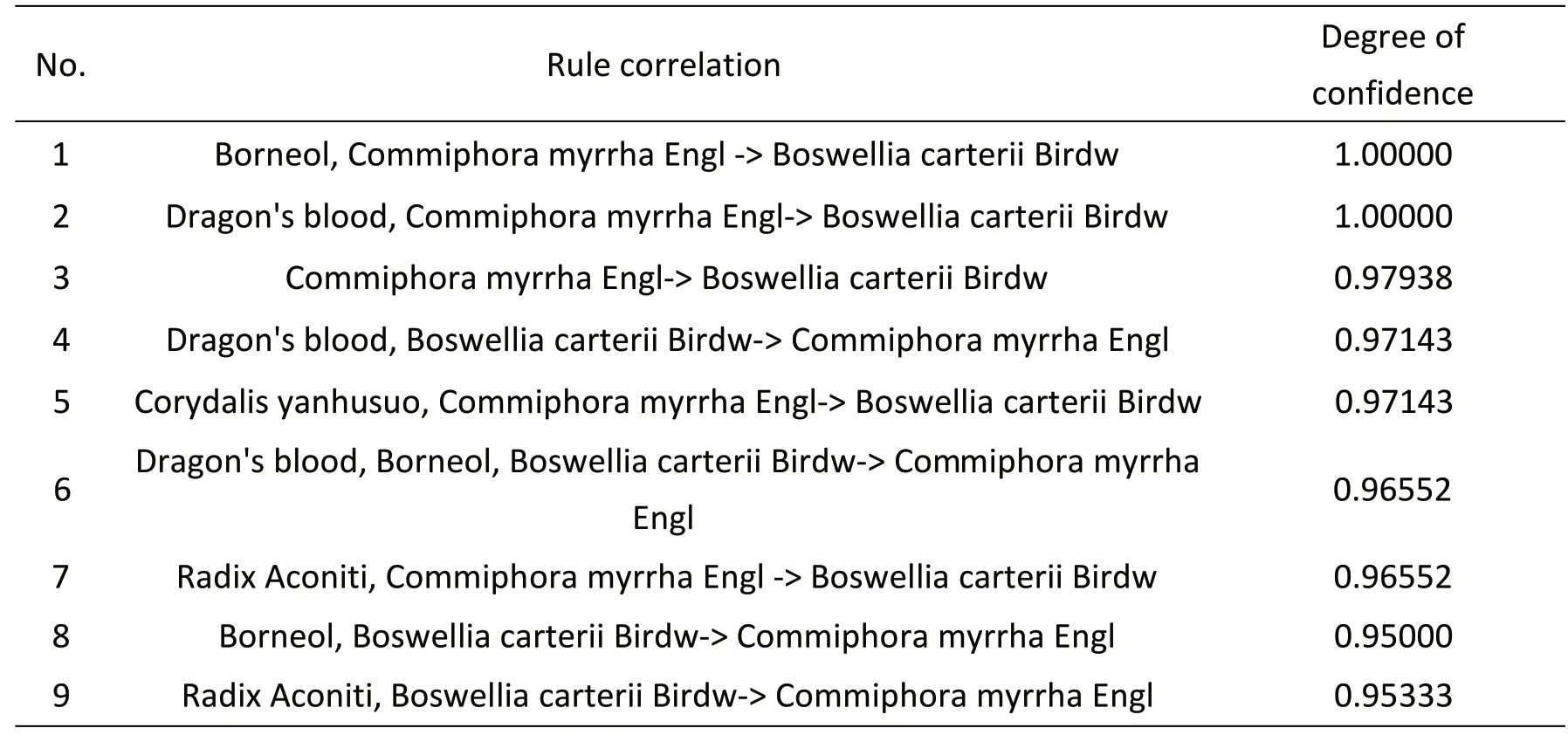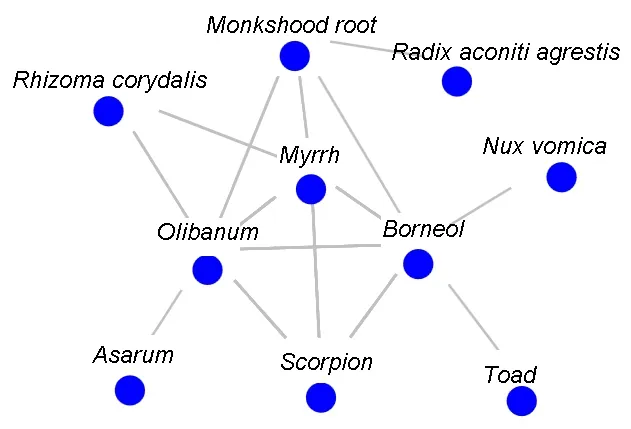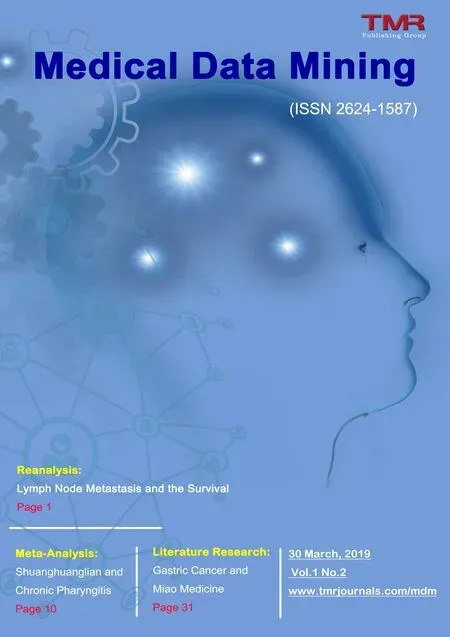Clinical Medicine Characteristics Study of Traditional Chinese Medicine in the treatment of cancer pain based on Data Mining
Hui-Li Shui, Zhu Yang, Feng-Xi Long, Wen-Qi Huang, Bing Yang, Zhen Zhang, Dong-Xin Tang,
1 Guiyang College of Traditional Chinese Medicine, Guiyang, 550002, Guizhou, China.
2 The Key Laboratory of Treatment on Chronic Pain by Miao Medicine Governed by The State Administration of Traditional Chinese Medicine, Guiyang, 550002, Guizhou, China.
AbstractObjective: To explore the clinical characteristics of traditional Chinese medicine in the treatment of cancer pain based on traditional Chinese medicine inheritance support system(TCMISS).Methods: China Chinese CNKI database, VIP database, Wanfang database(1979 - 2017) were searched to get the prescriptions for cancer pain treatment. At last, 290 prescriptions were got and used to, set up the cancer pain prescriptions database, The route of administration, medicinal properties and drug use frequency were analyzed, and the rules of drug use were analyzed by mining rules such as association rules and complex system entropy clustering.Results: A total of 286 drugs were involved, and the association rules of drug properties, taste, meridian tropism, drug frequency and drugs were defined, and 20 core combinations and 10 new prescriptions were developed.Conclusion: The clinical medication rule of Chinese medicine for treating cancer pain has been excavated, and its reflected drug philosophy of "Tong" is the main, the emphasis is on pain relief, "tonic" is the main, the emphasis is on harmony, qi and blood are treated together, the emphasis is on dredging,antitumor analgesic, treatment of symptoms and root causes is equally important.
Keywords: cancer pain; tumor; TCM; data analysis
1 Introduction
Cancer pain is one of the most common symptoms in cancer patients. The incidence of pain in newly diagnosed cancer patients is about 25%, and the incidence of pain in advanced cancer patients is about 60% to 80%, of which 1/3 suffer from severe pain [1]. At present, the treatment of cancer pain is mainly based on the WHO three-step analgesic regimen; the side effects bring great burden to the patients. Traditional Chinese medicine has the advantages of reducing toxicity and increasing efficiency,taking into consideration both the double track rolling mutual aid with strong opioids, slowly improving the treatment of cancer pain, and effectively supplementing the three-step analgesic therapy [2]. In this paper,the traditional Chinese medicine inheritance support system (TCMISS) was used to systematically analyze the prescriptions of traditional Chinese medicine for treating cancer pain, to develop new drugs and provide guidelines for the treatment of cancer pain.
2 Materials and methods
2.1 rescription source
Articles related to the treatment of cancer pain in Chinese medicine published from 1979 to 2017 were selected through China Knowledge Network, VIP Chinese Database, and Wanfang Database. After screening, 272 articles met the selection criteria, and a total of 290 prescriptions were found.
2.2 Inclusion criteria
(1) Literatures on the treatment of cancer pain using traditional Chinese medicine and integrated traditional Chinese and Western medicine; (2) definite clinical curative effect; (3) tumor type, pathological stage,stage, etc.; (4) route of administration including oral administration, external use or injection; (5) for modified formulae, only the base formula was included; for instances of repeated intake, only one intake will be considered.
2.3 Exclusion criteria
(1) Literature without definite cancer pain diagnosis; (2)literature review, experimental research, popular science literature; (3) drug composition is unclear; (4) literature on western medicine alone for treating cancer pain; (5)clinical efficacy is unclear.
2.4 Chinese medicine specification
Chinese medicine were standardized according to“Chinese medicine materia medica” [3] (13th Five-Year Textbook 2016 Edition), “Chinese Materia Medica” [4]including: (1) Standardized Chinese medicine aliases and common names, such as Xuanhu, Yuanhu to Yanhusuo,etc.; (2) Standardized Chinese medicine abbreviation,such as Tuyuan changed to Tubiechong.
2.5 Prescription entry and mining method
The prescription data was entered into the“Pharmaceutical Management” section of the V2.5 data management function of the traditional chinese medicine inheritance support system (TCMISS) to establish a cancer pain database. All prescription data were reviewed by two authors. Descriptive statistics were performed on the characteristics, taste, pertaining meridians,information on the route of administration and dosage.Cluster analysis from the “prescription analysis” software,association rules using Apriori algorithm, complex system entropy clustering and other mining methods were used to analyze the characteristics of the herbs,its taste, pertaining meridians, frequency of use, herbal prescription, etc. [5].
3 Results
3.1 Routes of administration and formula types
According to statistics, in the 290 Chinese medicine prescriptions for the treatment of cancer pain, 94 were administered orally, accounting for 32%; 191 were administered externally, accounting for 66%; 5 were administered by injection, accounting for 2%. Among them, 110 decoctions, accounting for 38%; 85 ointments,accounting for 29%; 58 powders, accounting for 20%; 17 drugs, accounting for 6%; 3 pills, accounting for 1%; 17 other dosage forms, Accounted for 6%.

Figure 1 the distribution of pharmaceutical dosage forms

Figure 2 the distribution of pharmaceutical properties
3.2 Pharmaceutical properties
The treatment of cancer pain is mainly warm in the medicine property for traditional Chinese medicine. In the taste of the medicine , it is mainly bitter, spicy and sweet. In the channel tropism of the medicine, the liver is the main, followed by the spleen and lung. (See Figure 2)
3.2 Common herbs
The 290 prescriptions for the treatment of cancer pain in traditional Chinese medicine involved 286 compounds;twenty-six of them were used more than 30 times. The top three compound with the highest frequencies were frankincense, borneol and myrrh (Table 1) .
3.4 Analysis of prescription formulas based on association rules
Based on the association rule mining method, the number of support degrees was set to "28", the confidence level is set to "0.9", and 22 combinations of drug combination frequencies were obtained at 28 or more times, as shown in Table 2. There are 9 correlation rules between the drugs whose drug confidence is greater than 0.9. See Table 3 for details and visualize the “network display”, as shown in Figure 3.

Table 1 Drugs with a frequency greater than 30 times

Table 2 Use of drug combinations with frequency more than 28 times

Table 3 Association rules for drug combinations in prescriptions

Figure 3 Network diagram of drug combinations in prescriptions
3.5 Analysis of prescription formulas based on entropy clustering
3.5.1 Analysis of drug association degree based on improved mutual information method
By excavating the correlation between the traditional Chinese medicine in the prescriptions, according to the number of prescriptions, comprehensive clinical experience judgment and different parameters to extract the pre-read values, setting the correlation degree to “8”and the penalty degree to “4”, and performing cluster analysis, the association between the two drugs, with a correlation coefficient greater than 0.01800 was obtained listed, as shown in Table 4.
3.5.2 Core drug combination analysis based on complex system entropy clustering
Based on the complex system entropy clustering, on the improved cross-information analysis results of the mutual information method, the core combination of 3-4 flavor drugs was evolved according to the correlation degree and the penalty degree. See Table 5 for details.
3.5.3 New prescription analysis based on unsupervised entropy hierarchical clustering
Through the unsupervised entropy hierarchical clustering algorithm, further clustering was performed on the basis of the above 20 core combinations, and 10 new parties were obtained, as shown in Table 6.

Table 4 Analysis table of drugs association between prescriptions (correlation coefficient ≥0.01800)

Table 5 Drug core combination based on complex system entropy clustering for cancer pain

Table 6 New formula for treating cancer pain based on entropy hierarchical clustering
4 Discussion
4.1 Clinical characteristics of traditional Chinese medicine in treating cancer pain
4.1.1 Analysis of the route of administration, form and drug taste and pertaining meridian
According to the perspective of the route of administration, traditional Chinese medicine is mainly used for the treatment of cancer pain, and the forms include decoction, fumigation, ointment, powder, et al. It is mainly administered directly through the skin,acupoints, and orifices, and the drug is brought to the disease through the absorption of local skin or meridians,which avoids the stimulation of the gastrointestinal tract by the drug and improves the speed of drug onset, which is suitable for patients with a critically advanced disease or
who cannot use orally administered drugs. It can be seen from Fig. 2 to Fig. 4 that traditional Chinese medicine for cancer pain have the following characteristics: bitterness,pungent, sweet and warm. Bitter energy can be expel, dry,and harden. Pungent can disperse. Sweet can reinforce and harmonise. Warmth can improve circulation. This embodies the treatment principle of "Gan Wen tonic,bitter cold and diarrhea". The drug is mainly based on the liver, followed by the spleen and lung. Liver stores blood, governs venting, smoothing the distribution of qi; the spleen is the main transport, the foundation of the postnatal qi, the source of qi and blood; the lungs governs the qi of the whole body, is connected to hundred veins, monitor the rhythm. They are related to qi and blood.
4.1.2 Characteristics of most frequently used drugs
It can be seen from Table 1 that the Chinese medicine drugs for the treatment of cancer pain has a frequency of 26 times, and the frequency of use of frankincense and borneol is extremely high, reaching 37% or more. The characteristics of frankincense are pungent, bitter, warm,pertains to the heart, liver, spleen meridians, disperse and warm, free flowing the five zang and six fu, outside the passage of the meridians, can not only disperse qi stasis,but also phlegm and pain, as the Compendium of Materia Medica suggested, "Frankincense fragrant sputum can enter the heart, free flow blood and reduce pain, so it is a drug for hemorrhoids, heart and abdominal pain", can be used to treat qi stagnation and blood stasis syndrome.Borneol is pungent, bitter, slightly cold, pertains to the heart, liver meridians; irrespective of external or internal use, it can relieve pain. According to the analysis of drug classification, frankincense, Borneol, Yanhusuo,Chuanxiong, Ma Qianzi, Xuee, Danshen, safflower, and Ezhu have the effect of promoting blood circulation and removing blood stasis, and promote the distribution of qi and used as analgesic drugs; borneol and medlar have the effect of opening the orifices and relieving pain. Quan e, and Wugong remove toxicity and disperse masses,resulting in the free flow of meridians and pain relief;Chuanwu and Caowu expel Wind damp, cold and relieve pain; Fuling is among the herbs that strengthen the spleen eliminating dampness. It embodies the traditional Chinese medicine treatment of cancer pain, the use of blood invigorating and qi moving analgesics.
4.1.3 Analysis of Group Based on Associations
In Table 2, commonly used drugs based on association rules include "myrrh, frankincense" (95), "borneol,frankincense" (60), "borneol, myrrh" (57), frankincense and myrrh are commonly used together. All have the effect of promoting blood circulation and relieving pain, such as suggested in Medical Heart in the West,"Frankincense, myrrh ... ... the combination of two drugs,for the purpose of dredging the viscera, free flow of meridians, so the heart and stomach, abdomen pain can be cured." And borneol has the function of opening and relieving pain, promoting blood circulation and removing blood stasis. "Ice borne, myrrh, frankincense" (57) is a common analgesic keratine. They are used together to enhance the effect of promoting blood circulation and relieving pain. As can be seen from Table 3, the combination of drugs with a confidence level of 1 is:borneol, myrrh, frankincense; blood, myrrh, frankincense.
These are the modifications of the classic name Qili San,which has the effect of decrease swelling, relieve pain and stop bleeding. The modern research shows that the effect of external application of Qilisan is significant, and it has the effect of dredging meridians, reducing swelling and relieving pain, and local cleansing [6]. Although the current research finds that this method is mostly used for the treatment of traumatic bloody pain, it is also applied to cancer pain. The treatment of pain should have considerable prospects.
4.1.4 Analysis of prescription formulas based on entropy clustering
Based on the complex system entropy clustering data mining method, based on the correlation analysis, 20 core combinations were obtained, and 10 new formulae were further explored. Analysis of the drug composition of New prescription 1 has the effect of replenishing spleen and kidney, replenishing qi and nourishing blood.Clinically, patients with spleen and kidney deficiency can consider the modification of this formula. New prescription 2 can decrease toxicity and disperse phlegm,remove blood stasis and relieve pain, and is more suitable for the use of patients with phlegm and blood stasis type; New prescription 3 have the functions of clearing away heat and detoxifying, dispersing and relieving pain. Clinically, patients with heat and toxic sputum can consider a modification of this formula; New prescription 4 can remove phlegm and stasis, reduce toxicity and relieve pain, and is also suitable for the treatment of blood stasis and spleen and stomach deficiency. New prescription 5 has the effect of replenishing qi and blood,promoting blood circulation and relieving pain. Patients with qi deficiency and blood stasis in clinical practice can consider using a modification of this formula; New prescription 6 has the functions of replenishing liver and kidney, nourishing qi and nourishing blood. The merits are more suitable for patients with liver and kidney yin deficiency; New prescription 7 have the functions of soothing the liver and releasing heat, replenishing qi and blood, and relieving pain. In clinical patients with blood deficiency and liver stagnation, we can refer to this side for addition and subtraction. New prescription 8 has the effect of strengthening the spleen and dissipating the phlegm, calming the nerves, and dissipating the pain. The patients with spleen deficiency and dampness can use modifications of this formula. New prescription 9 have the effect of dispelling cold and relieving pain, dissipating phlegm and stasis, more suitable for patients with cold stagnation type; New prescription 10 has the function of dissipating phlegm and dissipating qi, relieving pain and relieving pain. Patients with qi stagnation and stagnation type can refer to the modification of this formula.Throughout the evaluation, 10 new formulae have been developed, which shows that in Chinese medicine, the pathogenesis of cancer pain is nothing more than the"virtual and real" ends, and the treatment is based on"tonifying, dredging" approaches.
4.2 Chinese medicine treatment of cancer pain
4.2.1 Focusing on "dredging", pain relief
As Clinical Guidance Medical Case reported, "Injury into the network, qi and blood stasis, then the popular law,the so-called blocked passage result in pain." Chinese medicine believes that cancer pain is caused by blood stasis, qi stagnation, cold coagulation, accumulation of toxins, etc. [7]. From the frequency of drug use and the prescription, it can be known that the use of traditional Chinese medicine for the treatment of cancer pain drugs is not lacking in the "dredging" drugs such as qi painkillers, soft stagnation, blood circulation drugs, and phlegm drugs, among them, the New prescription 3, New prescription 8, New prescription 9, New prescription 10 and so on all have the function of "dredging", which all reflect the effect of "passing" to achieve pain relief.From the point of view of modern pharmacology, these drugs have significant anti-pain, anti-inflammatory, and immune-regulating effects, which are complementary to their understanding of the pathogenesis of cancer pain.
4.2.2 Tonification, with a focus on harmonizing
As Fang Shu said, "The deficiency if the exterior and painful, means that the yang is not enough, one should warm the meridian or it will be impossible. The imaginary and painful yin is not enough, one should nourish." Chinese medicine believes that if the Zheng qi is deficient, it is painful, through appropriate use tonifying herbs, the tumor treatment can be smoothly carried out, and the Zhengqi can be improved to prevent tumor, improve symptoms and improve clinical curative effect. Judging from the frequency of medicine and the law of prescription, Chinese medicine treats cancer pain and uses the products such as Astragalus, Codonopsis and Angelica. From the perspective of the New prescription 1, New prescription 5, New prescription 6,etc. all use the medicine of replenishing qi and blood to regulate the organs, all of which reflect the treatment of cancer pain by Chinese medicine, through the righting and strengthening of the blood, the body fluid and the function of the organs. To balance the yin and yang in order to achieve the effect of relieving pain, at the same time, it also reflects its "complement" as the main,focusing on the idea of medication.
4.2.3 The harmony between qi and blood is more important than dredging
Traditional Chinese medicine attributed the tumorrelated depression status to the category of "stagnation syndrome". Cancer pain is a source of physical and mental stress, which can induce and aggravate depression.[8] From the point of view of the use of the classics,the frequency of use of the liver meridian is the highest,reaching 149 times, reflecting the treatment of cancer pain in Chinese medicine, which is closely related to the liver, and the spleen and lungs. The stomach is related to qi and blood. New prescription 7 uses Chuanxizi to soothe the liver and qi stagnation, so that the liver is reached, so that the blood is smooth and the pain is relieved. Just as the Blood Syndrome reported, "With the liver, the wood is rushed and adjusted, and it will not be depressed. At the same time, the party also uses Shengdihuang to clear heat and fluid, cooling blood to stop bleeding; Gou ji nourishes the liver and kidney. It embodies the effect of traditional Chinese medicine in treating cancer pain with the treatment of qi and blood,soothing the liver and relieving pain relief.
4.2.4 Anti-tumor and pain relief
The "root" of cancer pain lies in "tumor". The premise of interventional cancer pain is to treat the tumor itself.It can be seen from Table 1 that the use of analgesic drugs and the use of anti-tumor drugs (such as scorpion,curcuma, centipede, toad etc.). From Table 4, the drug with high correlation coefficient is combined with the analgesic drug and the anti-tumor drug (such as Borneol and cinobufagin venom toad); see Table 5-6; the core combination for treating cancer pain 2, 4, 12 14, and New prescription 2, New prescription 4, etc. in the pain relief while taking into account the tumor inhibition. All of the above reflect the clinical concept of traditional Chinese medicine treatment using both the anti-tumor and analgesic appraoch.
4.3 Exploration on the new direction of traditional Chinese medicine in treating cancer pain
Based on data mining, this study analyzes the clinical characteristics of traditional Chinese medicine in the treatment of cancer pain, and reveals its drug concept.It suggests that in the future, Chinese medicine can treat cancer pain from the following eight aspects. 1 It is preferred to promote blood circulation and tonics. The drug may be preferably frankincense, borneol, myrrh; 3 drug pairs may preferably be frankincense, myrrh, etc.;and the 4 Jue drug may be preferred to frankincense,myrrh, borneol. 5 taking the core treatment as the main body, using the core combination of 3-4 flavor drugs, such as Rehmannia glutinosa, psoralen, mulberry parasitic, etc.; 6 attaching importance to compatibility,prefer a combination of drug association and high confidence, such as the modification of Qi Li San, etc. 7 According to the function of the new formula, develop new drugs for the corresponding type of cancer pain. 8 syndrome differentiation, internal and external treatment,emphasis on emotional factors is also an indispensable part of the treatment of cancer pain.
Funding:This research was supported by the National Natural Science Foundation of China Regional Science Foundation Project, Fund number:81460697; Guizhou Postgraduate Workstation Program (Educational Hall), Fund number: Guizhou teaching and research cooperation JYSZ word[2014] 018; National Natural Science Foundation of China Regional Science Foundation Project, Fund number: 81760814; Science and Technology Support Project in Guizhou Province, Fund number: Qian Kehe SY word [2014] No. 3026; Guizhou Provincial Department of Science and Technology - Guiyang College of Traditional Chinese Medicine Science and Technology Joint Fund Project, Fund number:Qian Kehe LH word [2014] No.7339; Science and Technology Support Project in Guizhou Province,Fund number: Qian Kehe SY word [2015] 3028-4;Fund project of science and technology department of guizhou province, Fund number: Qian Kehe Talents (2016) No.4032; Fund project of Guizhou education department, Fund number: Guizhou teaching and research cooperation GZS [2016]08;Science and Technology Foundation Project in Guizhou Province, Fund number: 81760814.
- Medical Data Mining的其它文章
- Literature Research on Drug Use Regulation of Miao Medicine in Suppression of Gastric Cancer
- Heating infusion for gastrointestinal complications in patients with enteral nutrition: A meta-analysis
- Efficacy and safety of atomized inhalation for Shuanghuanglian on chronic pharyngitis:a Meta-analysis of the randomized controlled trials
- Reanalysis of Lymph node metastasis as predictor of the survival of patients with follicular variant papillary thyroid carcinoma: From SEER database 2004-2014

